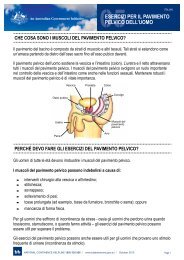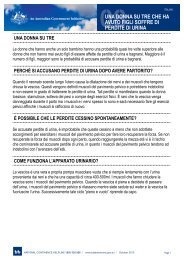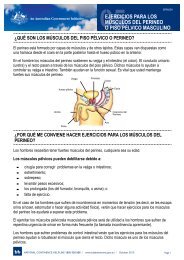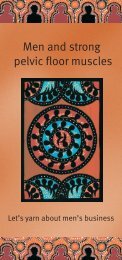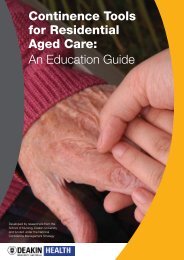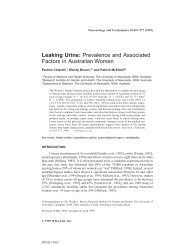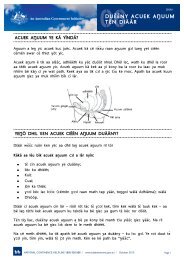Pharmacy Continence Care - Bladder and Bowel Website
Pharmacy Continence Care - Bladder and Bowel Website
Pharmacy Continence Care - Bladder and Bowel Website
You also want an ePaper? Increase the reach of your titles
YUMPU automatically turns print PDFs into web optimized ePapers that Google loves.
Executive Summary<br />
The <strong>Pharmacy</strong> <strong>Continence</strong> <strong>Care</strong> Project was commissioned by the <strong>Pharmacy</strong> Guild of<br />
Australia, through the Community <strong>Pharmacy</strong> Research <strong>and</strong> Development Grants Program, to<br />
develop, trial <strong>and</strong> evaluate a pilot program for national implementation <strong>and</strong> inclusion in the<br />
Quality <strong>Care</strong> <strong>Pharmacy</strong> Practice (QCPP) program that will:<br />
• provide community pharmacists <strong>and</strong> assistants with the information <strong>and</strong> skills to<br />
significantly raise community awareness of the issue of incontinence <strong>and</strong> to recognise<br />
<strong>and</strong> promote help-seeking strategies by their customers<br />
• promote widespread awareness of diagnosis <strong>and</strong> treatment services available<br />
• encourage individuals to seek readily accessible, appropriate <strong>and</strong> discreet information<br />
about their condition/symptoms.<br />
A first stage of the project, undertaken in 2003 by the Western Australia <strong>Continence</strong> Advisory<br />
Service, developed an education <strong>and</strong> training module for implementation in community<br />
pharmacies. The second stage was commissioned in October 2004 to develop, implement<br />
<strong>and</strong> evaluate a training program <strong>and</strong> materials for national roll-out in a subsequent stage of<br />
the project.<br />
NOVA Public Policy, a consortium of consultants in health, economic <strong>and</strong> social policy,<br />
undertook the second stage of the project, from October 2004 to November 2005, <strong>and</strong> this<br />
report presents the approach, methods, findings <strong>and</strong> outcomes of this stage.<br />
The NOVA approach to the pilot Program comprised six elements, running contiguously <strong>and</strong><br />
sequentially through the life of the project.<br />
In the inception phase, the NOVA project team consulted with the <strong>Pharmacy</strong> Guild of<br />
Australia research staff to establish the project plan <strong>and</strong> timetable <strong>and</strong> a strategy to recruit<br />
community pharmacies across Australia to participate in the project. NOVA also met with an<br />
expert panel of clinicians, pharmacists <strong>and</strong> a carer, put together by NOVA to advise on the<br />
development <strong>and</strong> implementation of the project.<br />
The desk research element of the project proceeded in parallel with element 3,<br />
Implementation of the Pilot Program, which comprised the recruitment of the research<br />
sample of participating pharmacies, <strong>and</strong> consultation with stakeholders on pharmacy,<br />
consumer issues <strong>and</strong> continence care information relevant to the project.<br />
The Stage 1 training materials <strong>and</strong> a substantial range of other continence education <strong>and</strong><br />
training materials, developed through the National <strong>Continence</strong> Management Strategy or<br />
identified through the literature review, were assessed <strong>and</strong> extensive adaptation of materials<br />
was undertaken with clinical, academic <strong>and</strong> consumer advice <strong>and</strong> guidance from members of<br />
the NOVA Expert Panel. The penultimate draft of the training materials was further reviewed<br />
by the medical <strong>and</strong> pharmacy professionals on the Expert Panel <strong>and</strong> by the <strong>Pharmacy</strong> Guild<br />
training manager, prior to submission to the <strong>Pharmacy</strong> Guild Expert Advisory Group in<br />
February 2005.<br />
The evaluation strategy for the project used a semi-structured two-stage telephone survey of<br />
the participating pharmacies—at baseline <strong>and</strong> following conclusion of the pilot Program—to<br />
measure change against Program objectives <strong>and</strong> performance indicators; <strong>and</strong> evaluation of<br />
consumer benefits through recruitment of customers (people with or at risk of incontinence,<br />
<strong>and</strong> carers) to a self-report survey instrument at enrolment (in-pharmacy) <strong>and</strong> by follow-up<br />
telephone interview at three months post baseline. Evaluation of sustainability of the<br />
Final Report ix NOVA Public Policy<br />
<strong>Pharmacy</strong> <strong>Continence</strong> <strong>Care</strong> Project



